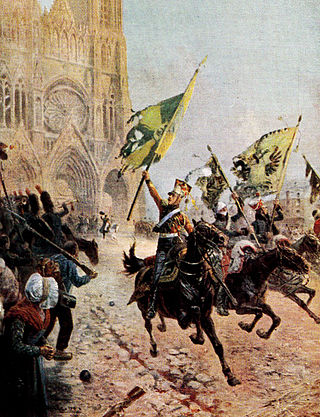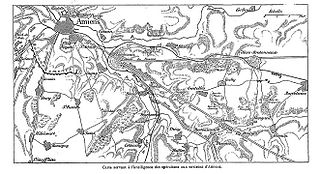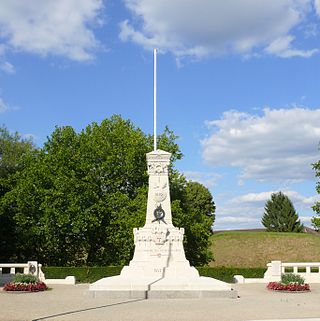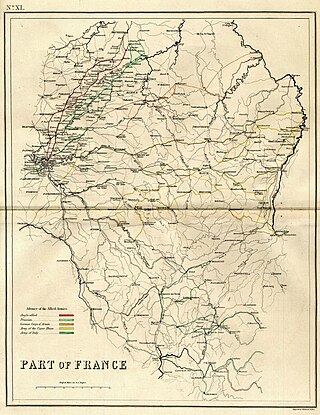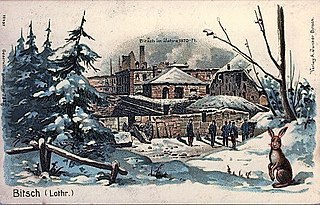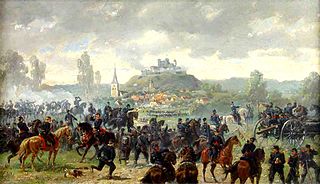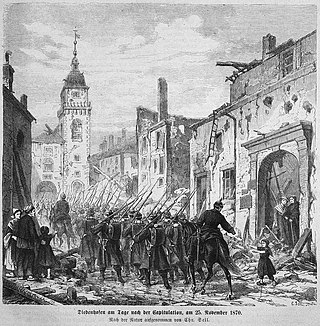September
The city of Laon, commanded by General Thémérin, had for a garrison of only a battalion and a battery of artillery of the mobile guard. However, on September 8, a strong detonation coming from the direction of Laon had been heard in Soissons. It was the powder keg that had blown. At September 10, a parliamentary dragoon officer of the 12th army corps, looked at the Porte Saint-Martin to request the surrender of the place. Colonel de Noue, commander of the place, categorically refused. The long German columns continued to march around Soissons towards Paris and the city was thus surrounded. On September 14, a group of German cavalrymen attempted a reconnaissance on the Porte de Reims. They are driven out by cannon and rifle fire. The same day a second parliamentarian demanded the surrender of the place. In response to a new refusal, the Germans fired 3 cannon shots on the city from the heights of Sainte-Geneviève. On September 18, warned by an inhabitant, a platoon of national guards in Venizel were surprised. On the same day, a detachment of about twenty Prussians were dispatched; one was killed, the others are taken prisoner. On September 22, 42 national guards carried out a coup de main against some German riders accompanying about sixty horses confined to Beugneux ; 1 officer and 2 German soldiers were killed, 18 were taken prisoner and 50 horses captured.
On September 24, 40 National Guards and 15th line fire on the Prussian cavalry in The Cottage in Venizel. Alerted, a Prussian battalion, soon joined by 3 battalions of the landwehr, force the National Guards to fall back after a hard fight on the hill of Villeneuve. The French lost 2 officers, 8 wounded and 16 missing and the Prussians 2 dead and 15 wounded. Following this engagement, the Grand Duke of Mecklenburg, Frederick Francis II of Mecklenburg-Schwerin, sent the following telegram from Reims to the Ministry of War in Berlin:
“On Saturday, we had a serious engagement under the walls of Soissons, after a four-hour fight, we forced the enemy to return to the city after having suffered great losses, the commander of the place asked for an armistice for bury his dead, we refused him. Signed: Duke Mecklenburg ” .
A parliamentarian again summoned Colonel de Noue to give him back the city, and faced with a new refusal, the German troops made their arrangements to completely invest the place, by installing grand guard positions, [11] by positioning battalions, mainly, on the Sainte-Geneviève plateau, in Billy-sur-Aisne and Venizel and by building shelters and defense works.
From September 25, the Prussian positions were bombarded by the French cannons. However, this did not prevent the Prussians from extending their supply lines and managed to occupy the station, which had been abandoned by the French which was Belleu , the left bank of the Crisis as far as Vauxbuin. and Presle. On September 26, 200 men of the 15th line accompanied by 100 men of 2 e Battalion mobile Aisne, went out to chase the Prussians in the suburb of Reims and burn their shelters. Unable to flush out the Germans, the attackers returned to the square after losing 2 dead and 2 wounded while the enemy lost 8 men. On September 27, fire was set in the foundry and part of the houses in the Faubourg Saint-Crépin in order to dislodge and drive away the Germans who were too close to the city walls, while many soldiers who had escaped from Sedan still arrived in the place. On September 28, the garrison tried to occupy the suburb of Reims and the station which was stopped by the Prussians after 2 hours of fighting.
October
On October 1, Lieutenant-General von Selchow arrived in front of Soissons to lead the siege, with reinforcements made up of 7 infantry battalions, 4 cavalry squadrons, 2 field artillery batteries and 2 pioneer companies. He established his headquarters at Carrière-l'Évêque located behind Belleu and on the hill. He extended and reinforced the line of investment on the left bank of the Aisne and brought it as close as possible to the French outposts. The Maison-Rouge farm was occupied as well as the cemetery blocking the road to Compiègne through which the French troops had been able to leave until then. The right bank was occupied by 2 companies of landwehrand a squadron of white cuirassiers. The infantry positioned themselves at Crouy and at Clémencin and behind the Laon railway embankment and the cavalry at La Perrière in order to monitor the roads to Chauny and Laon. On October 3, a food convoy made up of 18 cars managed to enter the square after the French troops stationed in Soissons had opened the passage to Crouy:
"To ensure the entry of supplies, Colonel Carpentier left with 6 companies taken in the two battalions of the mobile guard, and moved to the heights of Vauxrot. After having made the position clear and having settled down, he directed a company on Terny which brought the convoy into the place. To make the move, and clear the road of Laon, Ballet captain came out with 3 companies of the 15 th line . Lieutenant Ferté of the 1re company is focused on the farm St. Paul, Lieutenant Garnier of 2 th company on Clamecy Captain Felon, recruitment of the Aisne, with 3 e company supported this offensive movement, which took place with a remarkable whole. The enemy flushed out by a very strong fire, withdrew in disorder on the village of Crouy, pursued by about twenty skirmishers who took 6 prisoners, including 1 wounded. Our soldiers then occupied the ridges of the railroad embankment until they arrived in town. The losses are 1 killed and 3 wounded. Soissons on October 3, 1870. Signed De Noue, commandant of the place."
On October 5, by order of Colonel de Noue, the Vailly bridge was destroyed. “By order of the superior commander, the Vailly bridge must be destroyed. The guardian of the bridge, under penalty of treason, will have to let the order be carried out, if he warns the enemy, he will be brought before a council of war and shot. Soissons October 4, 1870. Signed De Noue. "
On October 6, informed of the destruction of the bridge, a detachment of around forty German cavalrymen entered Vailly and proceeded to arrest the mayor M. Mennessier and the councilor general of the canton M. Legry who were accused of "act Criminal expected and punished by the 4 th paragraph of the Royal Order of 21 July 1867 and the rescript of paragraph 18 of the military Penal Code " The Prussians were taken to the Carrière-l'Evêque where General de Selchow had his headquarters who rendered the following judgment:
“The town of Vailly will pay 20,000 francs as a fine for the act of hostility committed on its territory; one of the two prisoners will go to Vailly to get the money, the other will stay until his return, which will take place today."
From October 7 to October 11 the clashes continued: the besieged carried out harassment and bombing of outposts, while the besiegers, numbering 6,000 infantry, tightened their grip around the square:
On the left bank of the Aisne, from Venizel to the Crisis, 3 battalions and 1 light battery at the Château de Bellevue and at the Sainte-Geneviève farm, with the HQ in Billy-sur-Aisne. From the left bank of the Crisis to the Aisne, 3 battalions and 2 squadrons, with HQ in Vauxbuin. On the right bank of the Aisne, 1 battalion, 1 squadron and 1 battery, with the HQ at Ferme de la Perrière . A strong barricade, built by the Germans, cut off the road to Chauny, in anticipation of an exit of the besieged to the North. The line of outposts on the left bank started from the railway bridge near Villeneuve, followed the railway through the already dug trench to the station, then behind and after the Faubourg de la Crise, then passed in front of the mill of Buerie, the farms of Presle, Maupas and the Maison-Rouge on the road to Compiègne. The Germans built batteries to receive siege guns on October 12, the German artillery opened fire on Soissons. It was made up of:
4 fortress artillery companies (480 men) 2 reserve field batteries (320 men) 10 x 150 steel cannons 16 guns of 120 in bronze 6 guns of 90 (field artillery) 6 x 80 guns (field artillery) 2 mortars of 270 (taken in Toul or Marsal ) 4 mortars of 220 (taken in Toul or Marsal) 4 mortars of 150 (taken in Toul or Marsal) To which were added:
9 infantry battalions (7,200 men) 4 large cavalry squadrons (500 men) 2 pioneer companies (600 men) The first shells fell on the front [12] 3–4, the cavalier 27 and the arsenal.
All morning of October 12, the continuous cannonade of 73 German pieces shook the ground, destroyed houses, started fires and caused considerable damage and loss of life, despite the obstinacy with which the defenders responded, until the end of the day. On that day the Germans sent 1,864 shells, 184 shrapnels and 300 bombs.
On October 13, the cannonade was even more violent and many projectiles fell on the large barracks but also on a large number of houses causing new fires. At the beginning of the afternoon, a German parliamentarian appeared before Colonel de Noue who replied:
"That his duty and his honor did not allow him to capitulate, that the garrison was intact and ready to fight, that the pieces were recovered and ready to fire and that he was waiting for the Germans to assault the breach; he complained bitterly to the parliamentarian that the Germans were shooting at the city and the ambulances, although they were protected by the flag of the Geneva Convention, and that the siege was conducted in an inhuman manner since the fire was directed as much on the city as on the ramparts."
It was the fourth time that Colonel de Noue refused to surrender. The bombardment of the city resumed with a vengeance and with increased intensity. The Grand-Hôpital, which gave asylum to 300 people, caught fire under repeated blows from German artillery. The blows dealt by the besieger in this second day of bombardment were serious. On that day the Germans sent 1,993 shells, 225 shrapnels and 294 bombs.
On October 14, the human losses were less important; however the barracks, bastions numbered 3, 4, and 5 suffered heavy damage as well as the northern part of the fortifications whose German guns had breached from 33 to 35 meters and where an assault was now feared. Numerous letters addressed by the inhabitants of Soissons asked Colonel de Noue to stop this siege and to capitulate in order to put an end to the destruction, disasters, fires and victims. Mayor Henri Salleron also protested Lieutenant-Colonel de Noue against the bombardment:
"We should have expected," said the members of the municipal commission, "to endure a regular siege, but we should not believe that fifty hours of bombardment, with formidable devices, on positions which command the city on all sides, had to surrender almost useless any regular defense and wipe out much of the city, ” which went unanswered. These letters remained without effect.
On October 15, Henri Salleron sent a new missive to the military commander, giving a full account of the situation:
“Ruin, death and famine, this is the fate no longer of a third of the population but of more than half; only two districts are privileged until this hour: those surrounding the Place d'Armes and the Town Hall and most of the Faubourg Saint-Waast. Services of any kind become impossible; we can no longer even bury the dead and we no longer want to go get our bread. The inhabitants who have a habitable cellar, can remain locked there and put their existence in the shelter, but half of the population is obliged to await death in the houses, and if one bombed the suburb, it does not there is not a cellar that is not flooded, so no refuge. Besides, Colonel, I don't want to try to move you; I fully share your thoughts on the sacrifices imposed by patriotism, I appeal only to reason and, no more than you, I am not prepared to compromise with the enemy. Only, I understand all the possible sacrifices, life and fortune, only on condition of believing them useful. God knows if the present situation has not covered your military responsibility since yesterday. I had, not without difficulty, opened ditches at the place indicated, but, at two feet, we encountered water. As there are deaths of five days, I took it upon myself to have pits opened in the Jeu de Paume. (At the foot of the curtain wall 8–9, the corpses were brought in dumpers, 47 dead were thus buried and later transported to the city cemetery) I am not prepared to compromise with the enemy any more than you are. Only, I understand all the possible sacrifices, life and fortune, only on condition of believing them useful. God knows if the present situation has not covered your military responsibility since yesterday. I had, not without difficulty, opened ditches at the place indicated, but, at two feet, we encountered water. As there are deaths of five days, I took it upon myself to have pits opened in the Jeu de Paume (At the foot of the curtain wall 8–9, the corpses were brought in dumpers, 47 dead were thus buried and later transported to the city cemetery) "I am not prepared to compromise with the enemy any more than you are. Only, I understand all the possible sacrifices, life and fortune, only on condition of believing them useful. God knows if the present situation has not covered your military responsibility since yesterday. I had, not without difficulty, opened ditches at the place indicated, but, at two feet, we encountered water. As there are deaths of five days, I took it upon myself to have pits opened in the Jeu de Paume (At the foot of the curtain wall 8-9, the corpses were brought in dumpers, 47 dead were thus buried and later transported to the city cemetery) on the condition of believing them useful. God knows if the present situation has not covered your military responsibility since yesterday. I had, not without difficulty, opened ditches at the place indicated, but, at two feet, we encountered water. As there are deaths of five days, I took it upon myself to have pits opened in the Jeu de Paume (At the foot of the curtain wall 8-9, the corpses were brought in dumpers, 47 dead were thus buried and later transported to the city cemetery) " on the condition of believing them useful. God knows if the present situation has not covered your military responsibility since yesterday. I had, not without difficulty, opened ditches at the place indicated, but, at two feet, we encountered water. As there are deaths of five days, I took it upon myself to have pits opened in the Jeu de Paume (At the foot of the curtain wall 8–9, the corpses were brought in dumpers, 47 dead were thus buried and later transported to the city cemetery)".
In the afternoon, not having succeeded in deciding Colonel de Noue, Henri Salleron completed his presentation: “It is certain that you are unaware of the material state of our Hôtel-Dieu and our ambulances. If you want to visit them, you will see the most awful sight. 500 sick and wounded, threatened with asphyxiation in the cellars, are piled up on top of each other; in the corners, children and old people; more supplies following the hospital fire. In Saint-Léger, 150 wounded or sick piled up in the crypt. Since morning, I have been trying to accommodate the families driven from their homes by the fire and the destruction. I did what I could, but I won't find any more asylum. The fires continue, and I believe that no city has endured so much ruin and misery with more resignation. Up to you to enjoy."
Lieutenant-Colonel de Noue did not see the assistance arriving which he had had requested in Lille by Lieutenant-Colonel Carpentier, in the presence of the strong requests addressed to him, and of the almost desperate situation in which the place found itself. found, decided to consult the members of the Defense Council on the course to be taken, inviting them to each give their opinion, either for resistance or for capitulation. This meeting of the Defense Council was quite eventful and above all very painful for the local commander. Knowing that a long resistance was not possible and that new sacrifices were completely useless, Colonel de Noue decided to spare the city new ruins and the defense of new victims and resigned himself to propose to the besiegers the surrender of the city.
On October 16, at around 2 a.m., Colonel von Krensky carried the protocol of surrender: "1- Colonel von Krensky, Chief of Staff of 13 th army corps, charged the full powers of his Royal Highness the Grand Duke of Mecklenburg 2 - Lieutenant-Colonel de Noue, commander of the Place de Soissons. Article 1: The Place de Soissons with all the material it contains will be made available to HRH the Grand Duke of Mecklenburg. Article 2: The garrison of Soissons, comprising all the men who bore arms during the defense, whether in uniform or not, is a prisoner of war, are excepted from this article the national guards and the mobile guards who lived in the city before war was declared. Article 3: In consideration of the valiant defense of the place, all officers and senior employees with officer rank, who will undertake in writing their word of honor to no longer bear arms against Germany, nor to act in nothing against his interests during the current war, will be released. Those who agree to these conditions will keep their weapons, their horses, their effects and their servants. Article 4: Tomorrow, at two o'clock, the garrison, unarmed, will be led to the glacis of the Porte de Reims. Article 5: The war material, including flags, cannons, arms, horses, caissons, ammunition, etc., etc., will be delivered at three o'clock by the heads of departments to a Prussian commission. Article 6: All the military doctors will stay to treat the wounded. Article 7: In consideration of what the city has suffered, it will not suffer any other contribution than that of feeding the garrison, after exhaustion of the supplies left in the state stores. Done at Soissons, at eleven o'clock in the evening, on October 15, 1870. Signed: von Krensky and de Noue "



